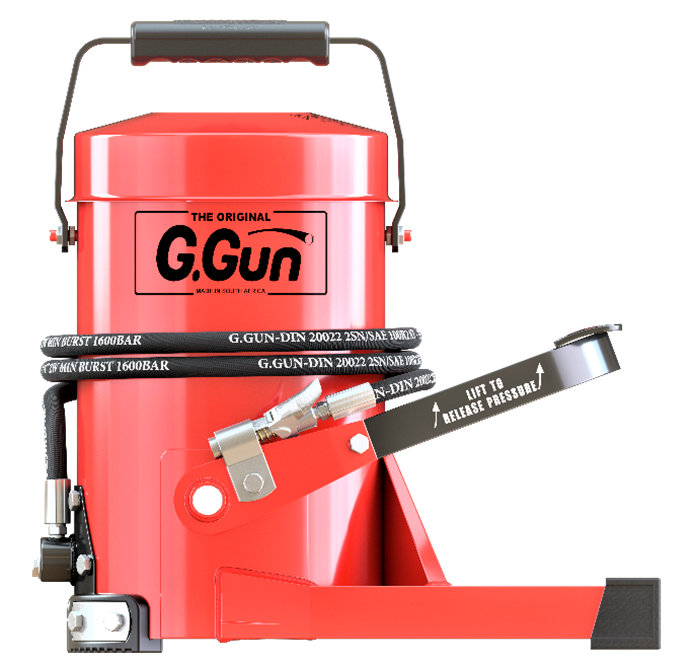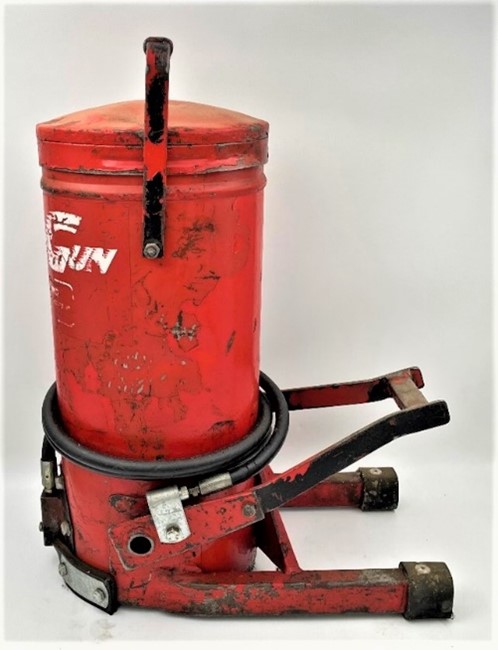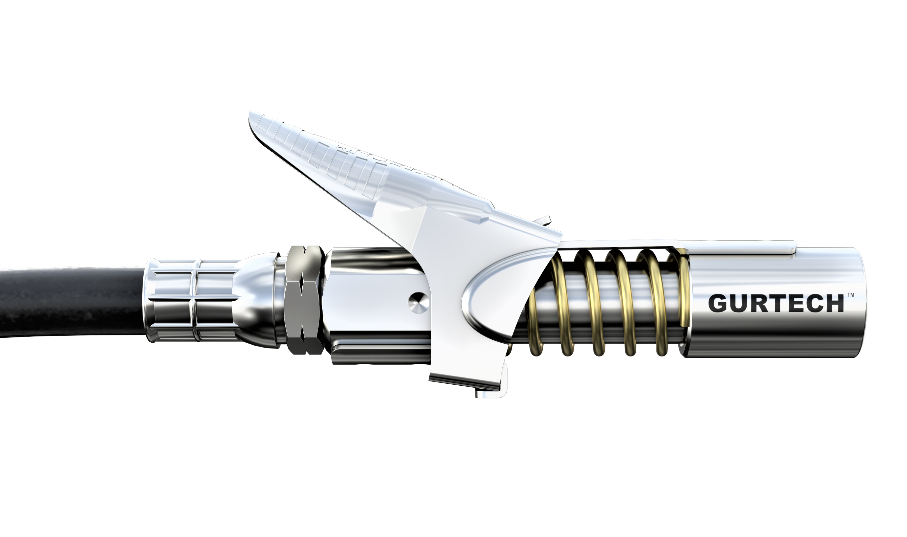
Back in the day, grease guns were pretty basic. The picture below shows a grease gun repurposed into a bell by my late father, Godfrey, circa 1955.
Back then, a grease gun was a rather basic instrument.

Is there a one-size-fits-all guide to how to innovate? The answer is no. A scan of my small library shows that there are many ways to tackle innovation.

Not quite an A to Z of innovation books, but we can see books by Arden, Brockman, Champy, De Bono, Foege, Godin and others.
There is nothing on TRIZ – possibly the most powerful innovation framework available - in my library. I need to plug that gap. For more on this approach, click on the image below.
So, rather than being theoretical, looking at a real-life example and seeing what lessons we can draw from it seems sensible.
Back in the 1980s, a South African farmer, Richard (Dick) Gurney (1935 to 2021) worked on developing an improved grease gun. He obtained a patent for it in 1988. It was an immediate success with his fellow farmers. Here is a picture of the original invention on the right alongside its descendant as manufactured some three decades on. Note the coupler on the current one, which coupler is still under patent. A close-up of the coupler is also shown below.



It wasn’t Dick's first invention. Previously he had installed an overhead pivot irrigation system. At the time, it was the biggest one in South Africa. The experts told him it couldn’t be done. So, he did it. Then waterlogged fields stopped him from harvesting his crop. So, he took the tracks off earthmoving equipment, fitted it to a combine harvester, and gathered the crop. Then he worked on developing innovative cane harvesting and loading equipment. But the only thing that drew abiding interest was the grease gun.
Then a drought derailed his plans. And he had to relocate his family and regroup on a smaller scale. He did this on a smallholding in the Midlands of KwaZulu-Natal. He persisted with the cane harvesting and loading ideas, but neither got beyond the early prototype stage. The grease gun product continued to sell - just.
His parents had farmed in the same area as the Lusso family and were friends. He persuaded young Cary Lusso – a generation younger than him - who had studied and obtained an Agricultural Engineering degree - to join the business to develop further the ideas of alternative cane loading and harvesting equipment. The cane harvesters were innovative but never got to the production stage. At that time, a family realignment saw Cary being given responsibility for the patented grease gun.
And that is where our story switches to the modern day. I recently had the opportunity to interview Cary Lusso and his fellow director Jonathon Akerman. It turned out to be a fascinating two hours. Below are some thoughts I gleaned from our wide-ranging discussion about the business – Gurtech – and some other ideas triggered by our conversation. Nine ideas are developed. I have also examined how their approach might map onto our Six ITs ™ framework.
1. Patents run their course, and you must keep innovating to stay in the game. While you may enjoy certain protection with a patent, it is under constant attack. For example, the company has had to buy, analyse, write reports on, and object to over 90 grease guns or grease gun accessories to protect one or other of their patents. This is to stop the marketing of offending products, all done at a high cost and use of scarce management time;
2. Patents are getting more challenging to secure. A practice known as mosaicing “allows a patent examiner to assess the inventive step in light of two or more pieces of the prior art information in combination, provided that a person skilled in the relevant art could reasonably have been expected to combine such information.” (alrc.gov.au). In other words, if your patent has three unique features and each can be found individually in a prior patent, then your patent can be refused;
3. When your patent runs out, you can stay in the game by ensuring better quality and adding little – sometimes patentable – refinements to your product. Quality and cost elimination are cornerstones of the company’s approach;
4. You need to pick your battles and niche. The most recent innovation in grease gun technology is one where they are powered by batteries. The batteries are interchangeable across several tools. Two companies dominate this market internationally. Going up against them directly would be futile and distract from the core business. However, you can develop add-ons which add value for the user;
5. Be guided by the market. The company has developed several products they thought would be winners that the market turned its nose up at. Your offerings must also be logically related, adding value for your core end user. Adding unrelated products to your range – no matter how innovative - makes no commercial sense;
6. Ideally, control your innovation process from start to finish. The company uses CAD/CAM and CNC and has its own tool and die-making section. This gives it control of key processes;
7. Innovation extends beyond your products. It is also central to your production process. While the company uses robotic welding machines, much of its plant has been purpose-built to ensure quality in every component and the minimum of waste. This extension of innovation to all aspects of the business makes it harder for competitors to match quality and cost;
8. Not every innovation needs to be patented. Small value-add items can achieve rapid payback on the R&D investment and may not warrant the costly process of patenting and protecting. Plus, they may not be patentable;
9. Relationships are central to success. These include those between a founder inventor who may sometimes be somewhat NIH (Not Invented Here) and the rest of the management team. Also, customers who move away to buy cheaper products and then find the quality of the replacement items are hurting their brand and need to return with no loss of face or grudges. Furthermore, sound relationships with distributors are vital. Gurtech is essentially a small family-owned business; some of its most vital and enduring distribution partnerships internationally are with other small family-owned businesses. Even though they may be involved in ongoing patent disputes, cordial relationships with major competitors are important.
While Gurtech does not need to undertake any significant pivots at present, it has done so in the past. Below is a diagram of the Six ITs and how I see it fitting the Gurtech approach.
Over the years, the business has built up an end-to-end innovation and production process. It can go from CAD/CAM, through prototype to tool or die-making in rapid order. Its management team has been exposed to industry forces and trends for years. Also, it has a small skilled workforce.
Beyond the collaboration that existed between the late founder and current management team members, the business has strong links to its distributors. This provides it with constant feedback on industry trends, competitor activities, and end-user demands. The MD also attends key tradeshows where direct feedback from end-users is obtained. This connectedness ensures that the business can respond rapidly to opportunities and threats.
The business has a clear sense of what and where its marketplace is. This understanding is shared by the management team and its distribution network. This means new product development is placed within a clear market context.
The business has innovation bred in its bones. It was born out of invention and continues to innovate. Both within the existing product line and in related applications of the technology that they have developed.
Quality management is taken very seriously, and all products undergo strict quality checks. Where competitors lure customers away with cheaper and inferior products, maintaining a reputation for consistent high quality is a significant advantage. Since many customers own-brand the company’s products, any product failure reflects on that company’s brand. So, paying more for a premium product makes sense as it helps these customers protect their brand.
The business continues to innovate and find new applications and market niches. Recent discoveries include a significant market niche starting to use one of the company’s products and an application for their patented delivery system that meets the needs of an existing market segment. These developments are closely guarded until market segments are openly targetted, or new product offerings are launched.
We trust you have enjoyed this story of innovation over more than three decades. And that some of the lessons we have identified assist you with your innovation journey.

Recent years have seen innovation become imperative for organisations.
Epidemics, wars, and major developments in artificial intelligence, machine learning, robotics, & big data have shifted the business terrain dramatically. Employee attitudes & expectations also continue to evolve.
To have a meaningful conversation with us about how we - the team at YourBigPic - can help you run an insightful rule over your plans and innovation leave your details below.